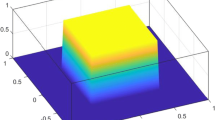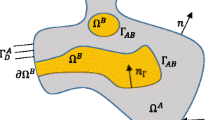Abstract
The topology optimization (TO) is a valuable tool in the early stages of structural engineering design. It enables the determination of the structural layout accounting for the required performance and utilizing less amount of material. In this study, an algorithm for TO is proposed, which is based on two computational procedures. On one hand the boundary element method (BEM), which is efficient for mechanical modelling and remeshing due to its mesh dimension reduction. On the other hand, the level set method (LSM) is an efficient approach to parameterize the design domain. Moreover, it handles complex topology changes without difficulties. The new feature presented here is showing a different formulation of the problem and explore its benefits. The idea is based on the augmented Lagrangian method in which shape sensitivity is used to drive the topology search. The shape derivative takes advantage of conformal and invertible mappings contributing for global stability. To reduce the susceptibility to local minima, a topology perturbation scheme based on local stresses is also adopted. The normal boundary velocity field may be locally singular. In this case the Peng regularization is utilized to maintain stability. These improvements make the algorithm convergent even on the presence of local instabilities. The LSM provides the structural geometry from its zero-level-set curve. Then, this curve is discretised through the BEM. The classical upwind fashion respecting strict CFL conditions is utilised for solving LSM equations. Local holes may be included at each time step, which enables topology changes based on local stress. Classical benchmark examples are used to illustrate the efficiency of the numerical procedure.











Similar content being viewed by others
References
Olhoff N (1996) On optimum design of structures and materials. Meccanica 31:143–161
Michell AGM (1904) The limits of economy of material in frame-structures. Philos Mag Ser 6 8(47):589–597
Bendsøe MP, Kikuchi N (1988) Generating optimal topologies in structural design using a homogenization method. Comput Methods Appl Mech Eng 71(2):197–224
Sigmund O, Maute K (2013) Topology optimization approaches. Struct Multidiscip Optim 48(6):1031–1055
Van Dijk NP, Maute K, Langelaar M, Van Keulen F (2013) Level-set methods for structural topology optimization: a review. Struct Multidiscip Optim 48(3):437–472
Huang X, Xie YM (2010) A further review of ESO type methods for topology optimization. Struct Multidiscip Optim 41(5):671–683
Rozvany GIN (2009) A critical review of established methods of structural topology optimization. Struct Multidiscip Optim 37(3):217–237
Bendsøe MP, Sigmund O (2003) Topology optimization: theory, methods, and applications, 2nd edn. Springer, Berlin, Heidelberg
Gao T, Xu P, Zhang W (2016) Topology optimization of thermo-elastic structures with multiple materials under mass constraint. Comput Struct 173:150–160
Tsavdaridis KD, Kingman JJ, Toropov VV (2015) Application of structural topology optimisation to perforated steel beams. Comput Struct 158:108–123
Yi S, Cheng G, Xu L (2016) Stiffness design of heterogeneous periodic beam by topology optimization with integration of commercial software. Comput Struct 172:71–80
Pedersen CBW, Allinger P (2006) Industrial implementation and applications of topology optimization and future needs. IUTAM Symp Topol Des Optim Struct Mach Mater 137:229–238
Schramm U, Zhou M (2006) Recent developments in the commercial implementation of topology optimization. IUTAM Symp Topol Des Optim Struct Mach Mater Status Perspect 137:239–248
Carpentieri G, Modano M, Fabbrocino F, Feo L, Fraternali F (2017) On the minimal mass reinforcement of masonry structures with arbitrary shapes. Meccanica 52(7):1561–1576
Christiansen AN, Bærentzen JA, Sigmund O (2015) Combined shape and topology optimization. Technical University of Denmark (DTU), Kongens Lyngby
Svärd H (2013) Interior value extrapolation—a new method for stress evaluation during topology optimization. In: 10th-WCSMO
Bendsøe MP, Sigmund O (1999) Material interpolation schemes in topology optimization. Arch. Appl. Mech. (Ingenieur Arch) 69(9–10):635–654
Osher S, Sethian JA (1988) Fronts propagating with curvature-dependent speed: algorithms based on Hamilton-Jacobi formulations. J Comput Phys 79(1):12–49
Sethian JA, Wiegmann A (2000) Structural boundary design via level set and immersed interface methods. J Comput Phys 163(2):489–528
Allaire G, Dapogny C, Delgado G, Michailidis G (2013) Multi-phase structural optimization via a level set method. Hal 20:576–611
Adalsteinsson D, Sethian JA (1995) A fast level set method for propagating interfaces. J Comput Phys 118(2):269–277
Adalsteinsson D, Sethian J (1999) The fast construction of extension velocities in level set methods. J Comput Phys 148(1):2–22
Sethian J (1999) Level set methods and fast marching methods. Cambridge University Press, Cambridge
Osher S, Fedkiw R (2004) Level set methods and dynamic implicit surfaces. Springer, New York
Abe K, Kazama S, Koro K (2007) A boundary element approach for topology optimization problem using the level set method. Commun Numer Methods Eng 23(5):405–416
Ullah B, Trevelyan J, Matthews PC (2014) Structural optimisation based on the boundary element and level set methods. Comput Struct 137:14–30
Ullah B, Trevelyan J, Ivrissimtzis I (2015) A three-dimensional implementation of the boundary element and level set based structural optimisation. Eng Anal Bound Elem 58:176–194
José Marczak R (2007) Topology optimization and boundary elements-a preliminary implementation for linear heat transfer. Eng Anal Bound Elem 31(9):793–802
Marczak RJ (2008) Optimization of elastic structures using boundary elements and a topological-shape sensitivity formulation. Lat Am J Solids Struct 5(2):99–117
Jing G, Isakari H, Matsumoto T, Yamada T, Takahashi T (2015) Level set-based topology optimization for 2D heat conduction problems using BEM with objective function defined on design-dependent boundary with heat transfer boundary condition. Eng Anal Bound Elem 61:61–70
Kublik C, Tanushev NM, Tsai R (2013) An implicit interface boundary integral method for Poisson’s equation on arbitrary domains. J Comput Phys 247:279–311
Yamasaki S, Yamada T, Matsumoto T (2012) An immersed boundary element method for level-set based topology optimization. Int J Numer Methods Eng 93(9):960–988
Aliabadi MH (2002) The boundary element method, volume 2, applications in solids and structures. Wiley, New York
Canelas A, Herskovits J, Telles JCF (2008) Shape optimization using the boundary element method and a SAND interior point algorithm for constrained optimization. Comput Struct 86(13–14):1517–1526
Lian H, Kerfriden P, Bordas SPA (2017) Shape optimization directly from CAD: an isogeometric boundary element approach using T-splines. Comput Methods Appl Mech Eng 317:1–41
Ullah B, Trevelyan J (2016) A boundary element and level set based topology optimisation using sensitivity analysis. Eng Anal Bound Elem 70:80–98
Brebbia CA, Telles JCF, Wrobel LC (1985) Boundary element techniques. theory and applications in engineering. Springer, New York
Allaire G, Jouve F, Toader AM (2004) Structural optimization using sensitivity analysis and a level-set method. J Comput Phys 194(1):363–393
Peng D, Merriman B, Osher S, Zhao H, Kang M (1999) A PDE-based fast local level set method. J Comput Phys 155(2):410–438
Piegl L, Tiller W (1996) The NURBS book. Comput Aided Des 28(8):665–666
Yamada T, Izui K, Nishiwaki S, Takezawa A (2010) A topology optimization method based on the level set method incorporating a fictitious interface energy. Comput Methods Appl Mech Eng 199(45–48):2876–2891
Eschenauer HA, Kobelev VV, Schumacher A (1994) Bubble method for topology and shape optimization of structures. Struct Optim 8(1):42–51
Rozvany GIN, Lewiński T (2012) Topology optimization in structural and continuum mechanics. CISM Advanced Course, Udine, pp 1–36
Vitório PC, Leonel ED (2017) Topology optimization analysis based on the direct coupling of the boundary element method and the level set method. Int J Adv Struct Eng 9(4):397–407
Tai K, Fenner RT (1999) Optimum shape and topology design using the boundary element method. Int J Solids Struct 36(14):2021–2040
Kim H, Querin OM, Steven GP, Xie YM (2003) Improving efficiency of evolutionary structural optimization by implementing fixed grid mesh. Struct Multidiscip Optim 24(6):441–448
Acknowledgements
Financial support for this research (Grant 2012/24944-5, 2015/07931-5) provided by São Paulo Research Foundation (FAPESP) is greatly appreciated.
Author information
Authors and Affiliations
Corresponding author
Additional information
Publisher's Note
Springer Nature remains neutral with regard to jurisdictional claims in published maps and institutional affiliations.
Electronic supplementary material
Below is the link to the electronic supplementary material.
Supplementary material 1 (MP4 5083 kb)
Clip 1 Cantilever beam with an inferior corner load immersed in an extended design domain (PNG 6 kb)
Supplementary material 4 (MP4 1495 kb)
Rights and permissions
About this article
Cite this article
Oliveira, H.L., Leonel, E.D. Boundary element method applied to topology optimization using the level set method and an alternative velocity regularization. Meccanica 54, 549–563 (2019). https://doi.org/10.1007/s11012-019-00954-z
Received:
Accepted:
Published:
Issue Date:
DOI: https://doi.org/10.1007/s11012-019-00954-z




